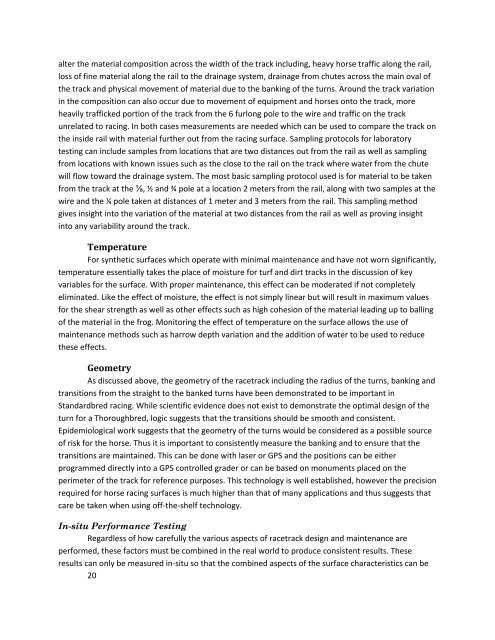Retired Racehorses
tfrr_reportandappendicesfinal
tfrr_reportandappendicesfinal
- No tags were found...
You also want an ePaper? Increase the reach of your titles
YUMPU automatically turns print PDFs into web optimized ePapers that Google loves.
alter the material composition across the width of the track including, heavy horse traffic along the rail,<br />
loss of fine material along the rail to the drainage system, drainage from chutes across the main oval of<br />
the track and physical movement of material due to the banking of the turns. Around the track variation<br />
in the composition can also occur due to movement of equipment and horses onto the track, more<br />
heavily trafficked portion of the track from the 6 furlong pole to the wire and traffic on the track<br />
unrelated to racing. In both cases measurements are needed which can be used to compare the track on<br />
the inside rail with material further out from the racing surface. Sampling protocols for laboratory<br />
testing can include samples from locations that are two distances out from the rail as well as sampling<br />
from locations with known issues such as the close to the rail on the track where water from the chute<br />
will flow toward the drainage system. The most basic sampling protocol used is for material to be taken<br />
from the track at the ⅛, ½ and ¾ pole at a location 2 meters from the rail, along with two samples at the<br />
wire and the ¼ pole taken at distances of 1 meter and 3 meters from the rail. This sampling method<br />
gives insight into the variation of the material at two distances from the rail as well as proving insight<br />
into any variability around the track.<br />
Temperature<br />
For synthetic surfaces which operate with minimal maintenance and have not worn significantly,<br />
temperature essentially takes the place of moisture for turf and dirt tracks in the discussion of key<br />
variables for the surface. With proper maintenance, this effect can be moderated if not completely<br />
eliminated. Like the effect of moisture, the effect is not simply linear but will result in maximum values<br />
for the shear strength as well as other effects such as high cohesion of the material leading up to balling<br />
of the material in the frog. Monitoring the effect of temperature on the surface allows the use of<br />
maintenance methods such as harrow depth variation and the addition of water to be used to reduce<br />
these effects.<br />
Geometry<br />
As discussed above, the geometry of the racetrack including the radius of the turns, banking and<br />
transitions from the straight to the banked turns have been demonstrated to be important in<br />
Standardbred racing. While scientific evidence does not exist to demonstrate the optimal design of the<br />
turn for a Thoroughbred, logic suggests that the transitions should be smooth and consistent.<br />
Epidemiological work suggests that the geometry of the turns would be considered as a possible source<br />
of risk for the horse. Thus it is important to consistently measure the banking and to ensure that the<br />
transitions are maintained. This can be done with laser or GPS and the positions can be either<br />
programmed directly into a GPS controlled grader or can be based on monuments placed on the<br />
perimeter of the track for reference purposes. This technology is well established, however the precision<br />
required for horse racing surfaces is much higher than that of many applications and thus suggests that<br />
care be taken when using off‐the‐shelf technology.<br />
In-situ Performance Testing<br />
Regardless of how carefully the various aspects of racetrack design and maintenance are<br />
performed, these factors must be combined in the real world to produce consistent results. These<br />
results can only be measured in‐situ so that the combined aspects of the surface characteristics can be<br />
20


